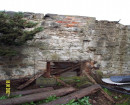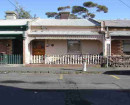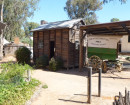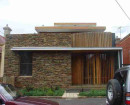WILKINSON MEMORIAL DRINKING FOUNTAIN
COMMONWEALTH RESERVE, NELSON PLACE WILLIAMSTOWN, HOBSONS BAY CITY
-
Add to tour
You must log in to do that.
-
Share
-
Shortlist place
You must log in to do that.
- Download report





Statement of Significance
What is significant?
The Wilkinson Memorial Drinking Fountain was inaugurated on 17 October 1876 by the Bishop of Ballarat, Dr Thornton, in the presence of the Mayor of Williamstown, ministers of all denominations and over 2000 people. It had been paid for by public subscription to commemorate the Reverend George Wilkinson, the local Anglican minister who had died the previous year. The cast-iron drinking fountain was imported from Glasgow where it had been cast in the Saracen Foundry of Walter Macfarlane & Co.
The cast-iron drinking fountain stands on a bluestone plinth made by monumental mason Harry Bliss in a corner of Commonwealth Reserve. The elaborate canopy comprises four columns rising to form arches with decorated mouldings, encircling ornamental shields, one of which reads "Wilkinson Memorial Drinking Fountain 1875", inscriptions on two sides of "Keep the pavement dry", and carvings of griffins, all surmounted by a richly decorated dome culminating in a crown. The pedestal and basin are also highly decorative, including carved reptilian creatures on the pedestal. The original copper water beakers were removed about 1935 and presently the fountain has two stainless steel taps.
How is it significant?
The Wilkinson Memorial Drinking Fountain has architectural, aesthetic, and historical significance to the State of Victoria.
Why is it significant?
The Wilkinson Memorial Drinking Fountain is architecturally significant as the earliest known memorial drinking fountain in Melbourne and one of the earliest in Victoria. It is also significant as one of the most ornate drinking fountains in Victoria and as a rare surviving example of an imported cast-iron drinking fountain. A number of similar ornamental fountains manufactured by Walter Macfarlane & Co of Glasgow were imported into Australia in the nineteenth century, but only one other example is known to exist in Victoria. The other example, the Henderson Drinking Fountain, North Melbourne, lost its original pedestal and basin in the 1950s.
The drinking fountain is aesthetically important as a fine example of Victorian decorative street furniture with elegant columns, richly ornamented arches and dome and elaborate carved figures.
The drinking fountain has historical significance for its associations with the Reverend George Wilkinson, Anglican minister at Holy Trinity, Williamstown who was also a temperance advocate and homeopath. The fountain also has strong historical associations with the temperance movement, a powerful religious, political and social force in Victorian society.
-
-
WILKINSON MEMORIAL DRINKING FOUNTAIN - History
Contextual History:History of Place:
The Wilkinson Memorial Drinking Fountain was inaugurated on 17 October 1876 by the Bishop of Ballarat, Dr Thornton. It was paid for by public subscription and imported from Glasgow where it had been cast by Walter MacFarlane & Co., architectural, sanitary and artistic founders, Saracen Foundry. The drinking fountain stands on a bluestone base made by monumental mason Harry Bliss.
The fountain commemorates the Rev George Wilkinson who had died the previous year. Wilkinson was an Anglican minister at Holy Trinity, Williamstown who was also a temperance advocate and homeopath with an extensive herb garden. The opening, attended by the bishop, mayor and ministers of all denominations, attracted a crowd of more than 2000 people, 600 of whom were children from various Sunday schools.WILKINSON MEMORIAL DRINKING FOUNTAIN - Permit Exemptions
General Exemptions:General exemptions apply to all places and objects included in the Victorian Heritage Register (VHR). General exemptions have been designed to allow everyday activities, maintenance and changes to your property, which don’t harm its cultural heritage significance, to proceed without the need to obtain approvals under the Heritage Act 2017.Places of worship: In some circumstances, you can alter a place of worship to accommodate religious practices without a permit, but you must notify the Executive Director of Heritage Victoria before you start the works or activities at least 20 business days before the works or activities are to commence.Subdivision/consolidation: Permit exemptions exist for some subdivisions and consolidations. If the subdivision or consolidation is in accordance with a planning permit granted under Part 4 of the Planning and Environment Act 1987 and the application for the planning permit was referred to the Executive Director of Heritage Victoria as a determining referral authority, a permit is not required.Specific exemptions may also apply to your registered place or object. If applicable, these are listed below. Specific exemptions are tailored to the conservation and management needs of an individual registered place or object and set out works and activities that are exempt from the requirements of a permit. Specific exemptions prevail if they conflict with general exemptions. Find out more about heritage permit exemptions here.Specific Exemptions:EXEMPTIONS FROM PERMITS:
(Classes of works or activities which may be undertaken without a permit under
Part 4 of the Heritage Act 1995)
General Conditions:
1. All exempted alterations are to be planned and carried out in a manner
which prevents damage to the fabric of the registered place or object.
2. Should it become apparent during further inspection or the carrying out of
alterations that original or previously hidden or inaccessible details of the
place or object are revealed which relate to the significance of the place or
object, then the exemption covering such alteration shall cease and the
Executive Director shall be notified as soon as possible.
3. If there is a conservation policy and plan approved by the Executive
Director, all works shall be in accordance with it.
4. Nothing in this declaration prevents the Executive Director from amending
or rescinding all or any of the permit exemptions.
5. Nothing in this declaration exempts owners or their agents from the
responsibility to seek relevant planning or building permits from the
responsible authority where applicable.
* Minor repairs and maintenance which replace like with like.
* Repairs to plumbing provided that they do not damage the fabric of the
fountain.
* Laying or removal of concrete or bitumen paving within the registered land.
-
-
-
-
-
FORMER MORGUE
 Victorian Heritage Register H1512
Victorian Heritage Register H1512 -
WILLIAMSTOWN PRIMARY SCHOOL
 Victorian Heritage Register H1639
Victorian Heritage Register H1639 -
RESIDENCE
 Victorian Heritage Register H0487
Victorian Heritage Register H0487
-
177 Fenwick Street
 Yarra City
Yarra City -
19 Cambridge Street
 Yarra City
Yarra City -
2 Derby Street
 Yarra City
Yarra City
-
-












